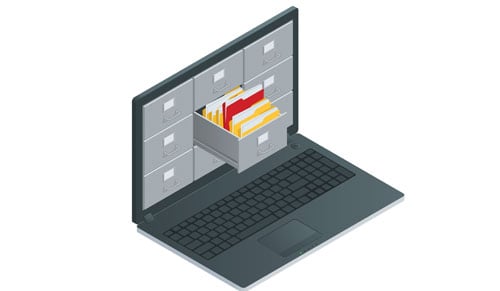If your SharePoint is several years old, there’s a good chance your teams are doing a few things the hard way.
Like everything in tech, intranets evolve fast. As things change, some standard practices start to fade from importance, eventually joining the great beyond where all outdated intranet features are laid to rest.
We’ve highlighted a few features that used to be common but have since outlived their usefulness. If you are still using these functions, it might be time to upgrade your platform and take advantage of newer capabilities.
1. Linear Workflows
Workflows have been a key component of SharePoint for years—used for everything from document approval to project feedback to collection signatures. In earlier versions of SharePoint, workflows were locked in a linear structure. You’d start a process at point A, go to point B, then to point C, and so on. Now workflows are dynamic. You can tweak them so a document can progress in a linear sequence, or go in a different order, depending on the needs of the users. In other words, you can go from A to point B, then E and back to D. You get the idea.
Organizational processes don’t always play out the same way every time. For instance, say you have a workflow for approving expense reports. An employee might submit a new report to a manager, who looks it over, makes sure everything is in order, then sends it to Finance for final approval and bookkeeping. However, maybe on one expense report, the manager sends the document back to the employee for a few changes.
A linear workflow would require the employee to send the document back to the manager, which is not always necessary if the changes are small. A flexible workflow would make it possible for the employee to send the revised report directly to the finance department, avoiding an extra step and ensuring greater speed and efficiency.
2. Manual Data Entry
The way organizations and their employees access data in their intranets has changed, thanks in part to advanced APIs. The most recent versions of SharePoint allow teams to integrate data from external sources through the use of JavaScript, AJAX, or other programming languages.
For example, technicians working in the field might need accurate weather data to do their jobs. Using the right APIs, you can configure your system so the weather data imports into SharePoint from a chosen source. You can use a similar strategy for other cases where external intelligence tools are instrumental for an organization’s day-to-day functions or services. In the past, employees would either have to access that data on their own—through phone apps or web browsing—or someone would have to enter the data manually into the system. These processes are less convenient and leave room for human error. Thankfully, we have left them in the dust.
3. Makeshift Co-Authoring
Before SharePoint 2013, real co-authoring and version control weren’t standard features in the platform. Collaboration was more of a makeshift process back then, riddled with opportunities for error. With the old system, you couldn’t have more than one person editing a document at a time, and once you saved that document, changes were permanent.
Now multiple people can edit a document in real-time with all changes saved and tracked by the person who made them. This system also creates new versions of a file every time it gets edited. As a result, it’s possible to revert to older versions of a file if one set of changes proves unnecessary or incorrect. These new features improve collaboration while also serving as a safeguard for important documents and data.
4. Folder and Subfolder Organization

With older versions of SharePoint, enterprises organized their sites and collections similar to the folder/sub-folder systems typically found on desktop computers. Managed metadata has made this practice obsolete. In fact, most SharePoint experts actively advise users not to use the folder/sub-folder method.
With managed metadata, you can build an entire taxonomy for your site. While earlier versions did allow for metadata tagging, they didn’t include managed metadata, which allows you to dictate how certain types of documents or files (referred to as “content types”) should be tagged.
For instance, you might require different fields or pieces of information for tagging an invoice than you would for a contract. Managed metadata ensures that everything in a specific category is tagged the same way, ensuring a consistent navigation across your entire SharePoint environment. This system makes it easy to find information based on how it is tagged. It’s a much quicker way to find things than having to navigate to the exact folder or sub-folder where a file resides.
When Should You Update SharePoint?
So how often should your enterprise be upgrading to new versions of SharePoint? Updates appear every year, but that doesn’t mean you need to reinvent your intranet on a regular basis.
The answer depends on how your company uses the intranet, the features you depend on, and how much customization is built into the platform. Some businesses upgrade every year or two. Others wait four years. You can bet that there are organizations out there still using SharePoint 2007 or 2010. If you are using Office 365, you don't need to worry about updates at all. Microsoft does it for you.
If you have hundreds of employees accessing your intranet every day—managing documents, collaborating with one another, and executing workflows—you should plan to upgrade every three or four years at a minimum. I wouldn’t put it off too long either way. Getting the most out of SharePoint means finding new ways of making your work easier. That’s harder to do when your portal is not evolving with the times.
We have helped brands like Keurig Green Mountain, Orvis, The Richards Group, and Subaru of Indiana transform their workplaces into collaboration hubs using our Accelerated Intranet. If you need help making improvements to your platform, we can help!
Share